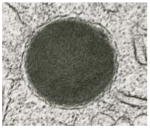Table 1.
Cytoplasmic granules in human eosinophils: past and present
| Past nomenclature | Current nomenclature | Ultrastructural features | Composition |
|---|---|---|---|
| “Secondary granules” | Specific granules |
 Mature granules with a centrally located crystalloid electron-dense core and an outer electron-lucent matrix, all bounded by a typical membrane. They are large (> 0.5 μm; ~700–1000 nm) and generally ellipsoid and occupy most of the cytoplasm in mature eosinophils [5, 7]. This distinctive granule morphology is found only in eosinophils. |
Cationic proteins, cytokines, chemokines, receptors, enzymes and growth factors [2, 6]. |
| “Primary granules” | Immature specific granules |
 Core-free granules of precursor cells of the eosinophil lineage. They are spherical, large (> 0.5 μm; ~600–1200 nm) and with a moderately dense or very dense amorphous material delimited by a typical membrane [34, 85]. Some immature granules can show intragranular vesicles. They are absent or rare in the cytoplasm of mature eosinophils but can be sometimes seen especially in newly formed eosinophils in response to diseases that recruit these cells. |
Cationic proteins [41], precursors of MBP [40], enzymes [34] and other proteins that are being formed in specific granules. |
| “Microgranules” “Small granules” |
EoSVs (Eosinophil Sombrero Vesicles) |
 EoSVs are not granules but vesiculotubular structures with cross-sectional diameters of ~150–300 nm. They appear as tubular, elongated, curved (C-shaped) and/or circular structures in thin sections [8, 54]. Frequently seen in contact or around specific granules because they are derived from these organelles and transport granule contents for extracellular release. Increased number in activated eosinophils. |
Positive for several granule compounds such as enzymes, IL-4 [54], MBP [51] and CD63 [9]. Also positive for IL-4Rα [55]. |
